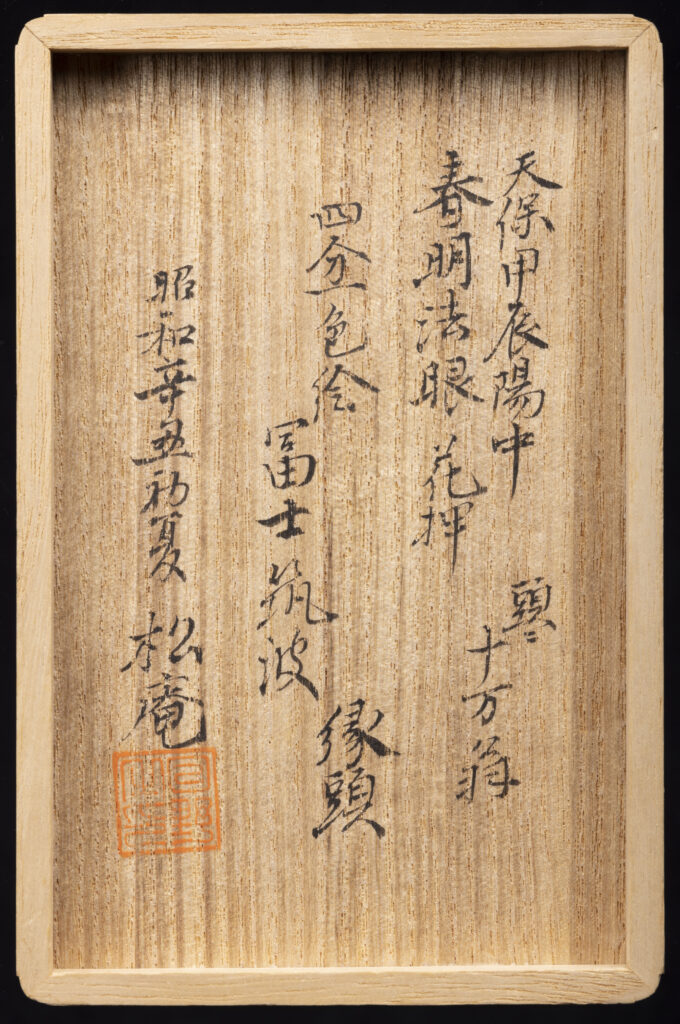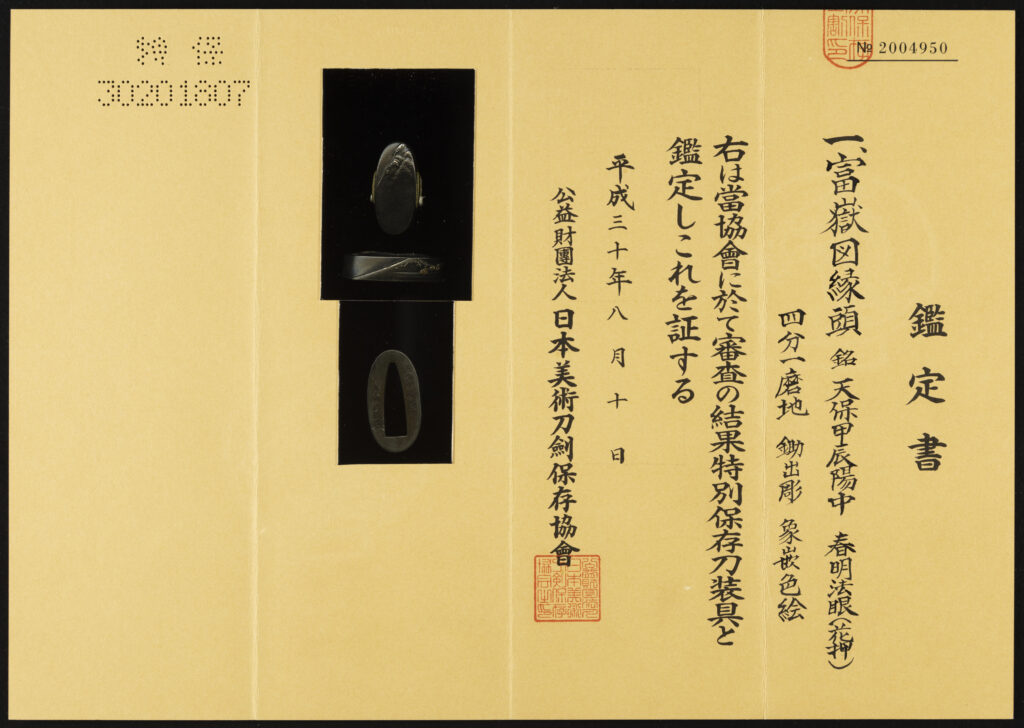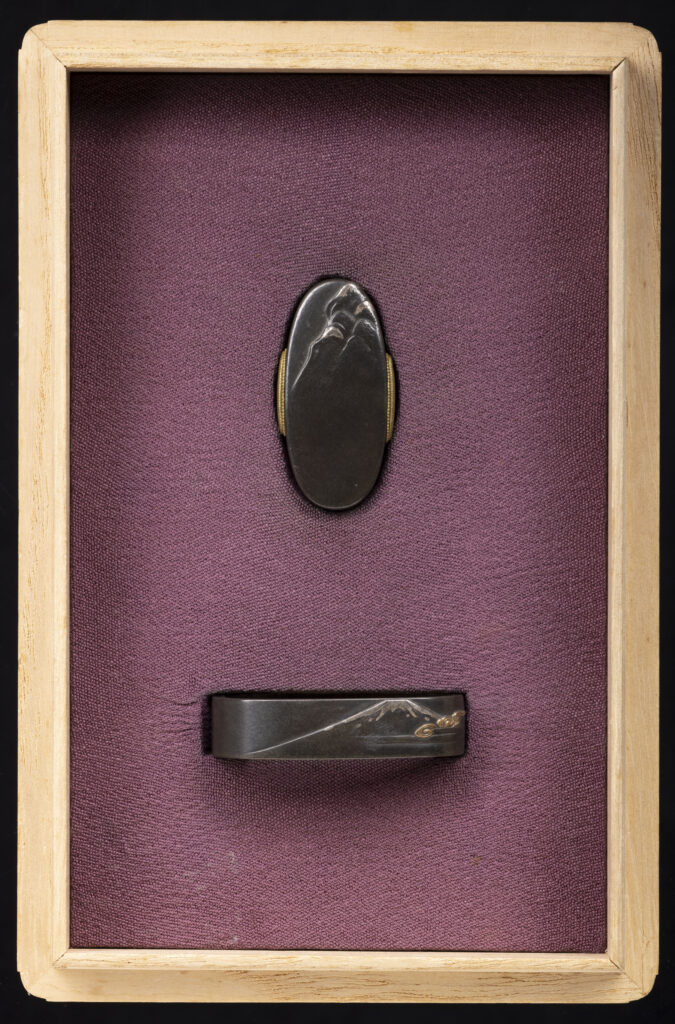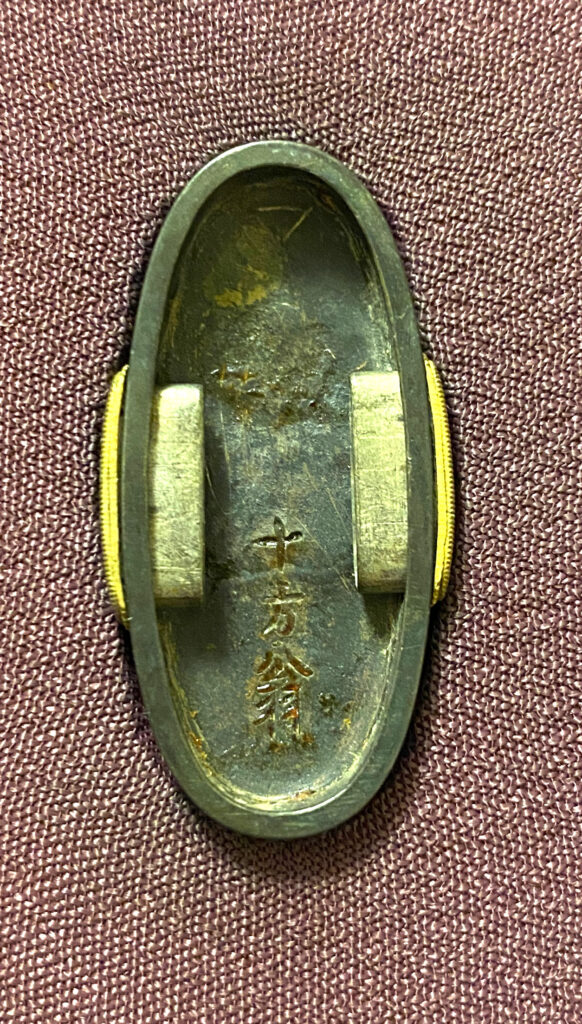Fuchigashira by Haruaki Hogen
Depictions of Fujisan (Mt. Fuji) can be seen frequently in sword fitting thematics. However, this pairing of Fujisan with Mr. Tsukuba is indeed unique and makes us take pause for the story between these two monoliths. Mt. Tsukuba is not very tall by comparison to other famous mountains in Japan. It also bears two peaks that makes it a little unique among notable mountains of Japan.
Haruaki Hogen’s illustration of these mountains is the story of humility versus arrogance, courtesy versus audacity, and generosity versus disdain.
Haruaki Hogen was born Chuzo Kono in Echigo province in 1787, and apprenticed himself to Naoharu of the Yanagawa school of fittings makers at the age of 16. He took the initial craftsman name of “Haruto”. His teacher, Naoharu, was regarded as being the most talented of the Yanagawa makers after the 1st generation, Yanagawa Naomasa who was himself a student of the imminent Yokoya Somin.
Haruta started his own workshop in Edo and changed his name to Haruaki, and at the age of 41, was elevated to the Buddhist rank of Hōgen, from his previous rank of Hokkyō. The former is the name by which he is most commonly referred to: “Haruaki Hōgen”. Around the time of this elevation, he relocated to Sendai and traveled to other places in the Northern regions, working as he traveled, as noted on a variety of his works.
He died in 1857 at the age of 71. The regard for his work is very high having been compared in skill with Goto Ichijo who worked in Kyoto.

The fuchi of this set depicts the grand and famous snowcapped “Fuji-san” standing among swirls of golden clouds. Mt Fuji is a popular and evocotive theme that scores of artists have undertaken over centuries of art in numerous mediums. The depiction of it rarely requires any deep explanations. However, this case a bit different in that Fuji-san shares the spotlight with another lesser famous unusually double-peaked mountain in the east named Tsukuba-san or “Mt. Tsukuba”.
Legend says that a deity asked for a place to rest for a night. Fuji-san being the tallest and most majestic of mountains for it’s grand and impressive shape, refused the request and any blessings that it did not need. Tsukuba-san on the other hand, enthusiastically and humbly welcomed the deity with a place to rest, food, and water. Thereafter, Mt. Tsukuba was blessed with abundant growth of flora and fauna, and embraces the seasons in brilliant color changes, while Fuji-san remains barren, rugged, and lonely.
The moral of that story is quite clear….
Another legend, and one that is celebrated and worshiped at the shrine at it’s base and each of the two on Tsukuba-san’s twin peaks tell the story of the birth of Japan. The pair of peaks, Nantai and Nyotai, are the embodiment of male and female, and enshrined there are the two deities Izanagi-no-Mikoto and Izanami-no-Mikoto who after being wedded, gave birth to Japan starting with Mt. Tsukuba.
Tsukuba san is also nick-named “The Purple Mountain” for its color at sunrise, and there are half a dozen or so other very interesting stories and legends surrounding it, but they drift beyond the intended scope of this fuchigashira.
Signed on the interior of the kashira; “Jippō’ō”

Hakogaki by Hino Shou’an
天保甲⾠陽中 Tenpō kinoe-tatsu yōchū
春明法眼「花押」 Haruaki Hōgen [kaō]
頭ニ⼗万翁 Kashira ni Jippō’ō
四分⼀⾊絵 Shibuichi iroe
冨⼠筑波縁頭 Fuji-Tsukuba uchigashira
昭和⾟丑初夏松庵「印」 Shōwa kanoto-ushi shoka Shō’an [ in]
[Signed] Second month in the year of the dragon of the Tenpō era (1844)
Haruaki Hōgen + monogram
And [signed] on the kashira: Jippō’ō
Of shibuichi and with iroe accents
Fuchigashira depicting Mt. Fuji and Mt. Tsukuba
April in the year of the ox of the Shōwa era (1961), Shō’an [monogram]
Special thanks to Markus Sesko for his script transliteration and translation
Dimensions
Fuchi: 3.8 cm x 2.25 cm
Kashira:

This is an excellent set of top-class artisan work that would have a proud place in any collection. It is accompanied by an NBTHK Tokubetsu Hozon certificate attesting to it quality and authenticity. The kashira also holds two masterfully crafted shitodome in gold rims with silver sleeves.
On Consignment: SOLD!


